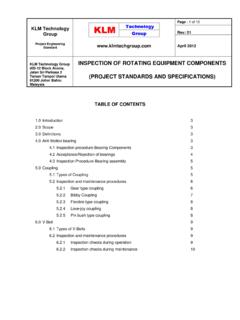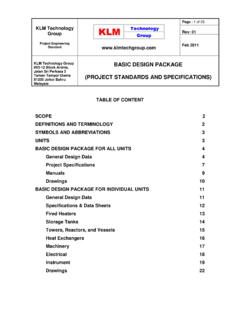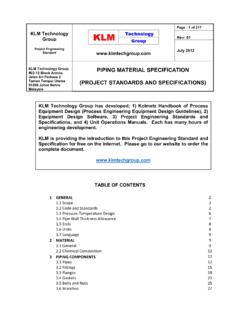Transcription of Distillation Column Tray Hydraulics Selection, Sizing and ...
1 KLM Technology Group Practical Engineering Guidelines for Processing Plant Solutions ENGINEERING SOLUTIONS Page : 1 of 50 Rev: 01 Feb 2011 KLM Technology Group P. O. Box 281 Bandar Johor Bahru, 80000 Johor Bahru, Johor, West Malaysia kolmetz handbook Of Process Equipment Design Distillation Column Tray Hydraulics Selection, Sizing and Troubleshooting (ENGINEERING DESIGN GUIDELINES) co author : Rev 01 aprilia Jaya Author / Edidtor: Karl kolmetz TABLE OF CONTENT INTRODUCTION 4 Scope 4 Type of Tray Distillation 5 General Design Consideration 13 Tray Hydraulic Parameter 15 DEFINITION 29 NOMENCLATURE 32 THEORY OF THE DESIGN 34 (A). Tray Work 34 (B). Physical Properties 35 (i) Density 35 KLM Technology Group Practical Engineering Guidelines for Processing Plant Solutions kolmetz handbook Of Process Equipment Design Distillation Column Tray Hydraulics Selection, Sizing and Troubleshooting (ENGINEERING DESIGN GUIDELINES) Page 2 of 50 Rev: 01 Feb 2011 These design guideline are believed to be as accurate as possible, but are very general and not for specific design cases.
2 They were designed for engineers to do preliminary designs and process specification sheets. The final design must always be guaranteed for the service selected by the manufacturing vendor, but these guidelines will greatly reduce the amount of up front engineering hours that are required to develop the final design. The guidelines are a training tool for young engineers or a resource for engineers with experience. This document is entrusted to the recipient personally, but the copyright remains with us. It must not be copied, reproduced or in any way communicated or made accessible to third parties without our written consent. (ii) Viscosity 36 (iii) Surface Tension 36 (C). Principal of Mass Transfer 36 (D). Tray Calculations 37 (i) The Selection of Pass Tray 37 (ii) Weep Point 38 (iii) Plate Pressure Drop 39 (iv) Downcomer Design 45 (v) Entrainment (Jet Flooding) 47 (vi) Tray Efficiency 50 APPLICATION 54 REFEREENCE 59 LIST OF TABLE Table 1: The Detail of Cap Size and Weir Height 22 Table 2: RVW, KC, KO, VM Valve 42 LIST OF FIGURE Figure 1: Internal of Bubble Cap Tray 6 Figure 2: Sieve Tray 7 Figure 3: Dual Flow Tray 8 KLM Technology Group Practical Engineering Guidelines for Processing Plant Solutions kolmetz handbook Of Process Equipment Design Distillation Column Tray Hydraulics Selection, Sizing and Troubleshooting (ENGINEERING DESIGN GUIDELINES) Page 3 of 50 Rev.
3 01 Feb 2011 These design guideline are believed to be as accurate as possible, but are very general and not for specific design cases. They were designed for engineers to do preliminary designs and process specification sheets. The final design must always be guaranteed for the service selected by the manufacturing vendor, but these guidelines will greatly reduce the amount of up front engineering hours that are required to develop the final design. The guidelines are a training tool for young engineers or a resource for engineers with experience. This document is entrusted to the recipient personally, but the copyright remains with us. It must not be copied, reproduced or in any way communicated or made accessible to third parties without our written consent.
4 Figure 4: Valve Tray 9 Figure 5: Kind of Baffle Tray; (a) Shed Deck Tray, (b) Side to Side Tray, (c) Disk and Donuts Tray 11 Figure 6: Typical Operating Region of Tray Column 16 Figure 7: Type of downcomer; (a) Sloped downcomer, (b) Straight Downcomer, (c) Truncated downcomer, (d) Steparc downcomer 19 Figure 8: Tray Components 25 Figure 9: Two Pass Tray Components 26 Figure 10: Three Pass Tray Components 27 Figure 11: Four Pass Tray Components 28 Figure 12: Schematic Description of a Tray Section 35 Figure 13: Selection of Liquid Flow Arrangement 38 Figure 14: Weep Point Correlation 39 Figure 15: Orrifice Coefficient on Sieve Tray 44 Figure 16: Relation between Downcomer Area and Weir Length 45 Figure 17: Liquid Height in The Tray 47 Figure 18: Fair Coefficient 48 Figure 19: Entrainment Correlation 49 KLM Technology Group Practical Engineering Guidelines for Processing Plant Solutions kolmetz handbook Of Process Equipment Design Distillation Column Tray Hydraulics Selection, Sizing and Troubleshooting (ENGINEERING DESIGN GUIDELINES) Page 4 of 50 Rev.
5 01 Feb 2011 These design guideline are believed to be as accurate as possible, but are very general and not for specific design cases. They were designed for engineers to do preliminary designs and process specification sheets. The final design must always be guaranteed for the service selected by the manufacturing vendor, but these guidelines will greatly reduce the amount of up front engineering hours that are required to develop the final design. The guidelines are a training tool for young engineers or a resource for engineers with experience. This document is entrusted to the recipient personally, but the copyright remains with us. It must not be copied, reproduced or in any way communicated or made accessible to third parties without our written consent.
6 INTRODUCTION Scope This design guideline covers the basic elements of tray Hydraulics in sufficient detail to allow an engineer to design a trayed tower with the suitable size of tray spacing, weir height, holes, down-comer, and open area. These factors will influential flooding and weeping, and will effect the tray performance, capacity and efficiency. The design of trays depends on the density, the rate of vapor and liquid through the tray. Each tray in a Distillation Column is designed to promote contact between the vapor and liquid on the stage, so there is mass and heat transfer. Ideally, the vapor and liquid leaving the stage are in equilibrium. Equilibrium is a function of the rate of mass and heat transfer between liquid and vapor in Distillation and it has an effect on the efficiency of tray. To increase efficiency and capacity of tray, a system is needed which will cover the whole spectrum of tray applications. One of the keys to make good quality products and high purities is tray Hydraulics .
7 Parameters of tray Hydraulics beside the geometry of the tray as it mention in first paragraph, are vapor-liquid loading, the allowable pressure drop on the tray and in the downcomer, flooding, turndown and weir loading. The design of tray Hydraulics may be influenced by many factors, including process requirements, economics and safety. In this section, there are tables that assist in making these factored calculations from the various reference sources. Generally, path flow liquid on tray is divided into single pass, two pass, three pass, and four pass. In this guideline, these differences will be discussed in detail for the proper engineering design for vapor-liquid loading and down comer design. The theories used in this guideline are commonly used in industries such as Bennet, Van Winkle, Fair and Eduljee. Their application to tray hydraulic theory with examples will help the engineer understand tray Hydraulics and be ready to perform the actual design of the trayed tower.
8 KLM Technology Group Practical Engineering Guidelines for Processing Plant Solutions kolmetz handbook Of Process Equipment Design Distillation Column Tray Hydraulics Selection, Sizing and Troubleshooting (ENGINEERING DESIGN GUIDELINES) Page 5 of 50 Rev: 01 Feb 2011 These design guideline are believed to be as accurate as possible, but are very general and not for specific design cases. They were designed for engineers to do preliminary designs and process specification sheets. The final design must always be guaranteed for the service selected by the manufacturing vendor, but these guidelines will greatly reduce the amount of up front engineering hours that are required to develop the final design. The guidelines are a training tool for young engineers or a resource for engineers with experience.
9 This document is entrusted to the recipient personally, but the copyright remains with us. It must not be copied, reproduced or in any way communicated or made accessible to third parties without our written consent. Included in this guideline is an example data sheet which is generally used in the industry and a calculation spreadsheet for the engineering design. Types of Tray Distillation Column Distillation is the most widely used separation process in the chemical industries. It is normally used to separate a mixture of materials to obtain one or more desired products which is achieved by selection of conditions of temperature and pressure so that at least a vapor and a liquid phase coexist and a difference in relative concentration of the materials to be separated in the two phases is attained. Trays are the most commonly selected type of Distillation Column . Trayed Columns utilize a pressure and temperature differential to separate the products.
10 For most tray columns, the weir holds a liquid level of each tray. The vapor must overcome this liquid head to move up the Column . On the tray the vapor and liquid are contacted and then above the tray they are separated. Trayed Column perform well in high liquid and vapor loading. At low flow parameters the capacity and efficiency of trays can be reduced. Tray have higher pressure drop than packing, and it may also have higher resistance to corrosion. Some other items are to consider when to use trays in a tower. 1. Usually trays have downcomer capacity problems in heavy foaming service. 2. Trays have higher pressure drop than structured packing Column 3. Trays have a high resistance to corrosion 4. Entrainment is an issue with trays. Trays usually have more entrainment than packing. Excessive entrainment can lead to efficiency loss 5. Excessive vapor and liquid maldistribution can lead to a loss of efficiency in a tray tower.










